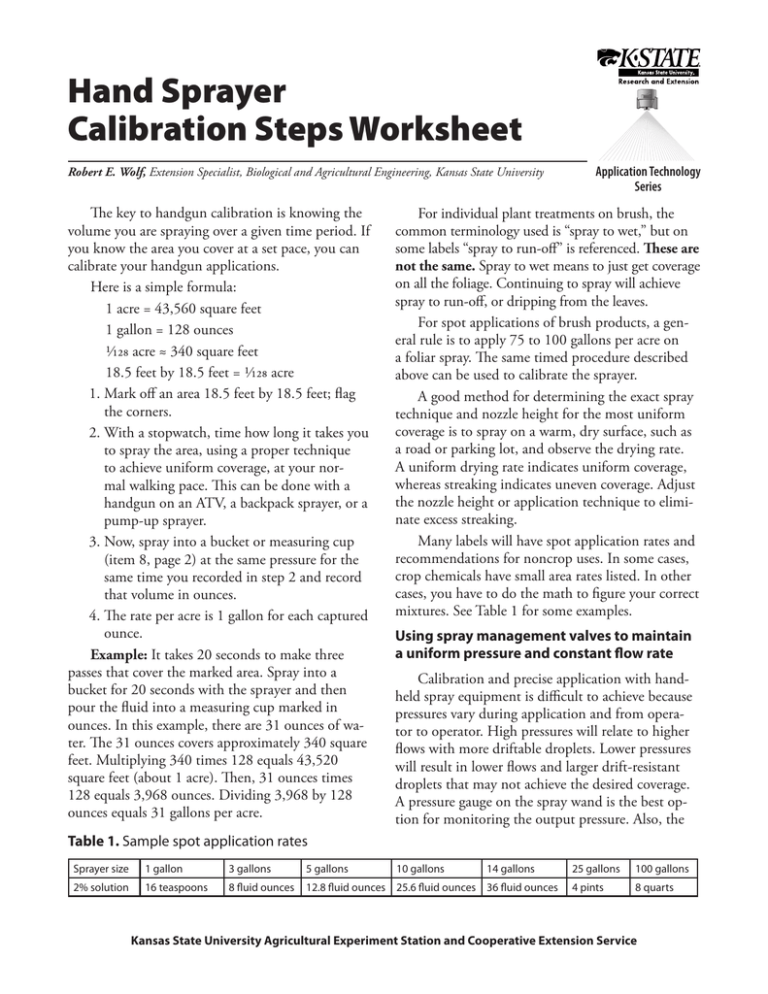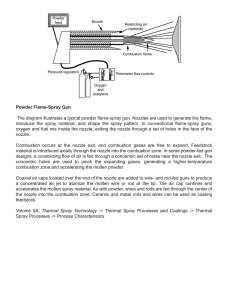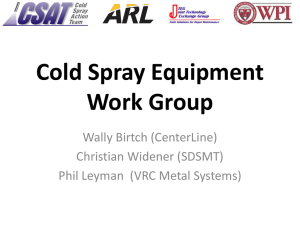
Hand Sprayer
Calibration Steps Worksheet
Robert E. Wolf, Extension Specialist, Biological and Agricultural Engineering, Kansas State University
The key to handgun calibration is knowing the
volume you are spraying over a given time period. If
you know the area you cover at a set pace, you can
calibrate your handgun applications.
Here is a simple formula:
1 acre = 43,560 square feet
1 gallon = 128 ounces
1/128 acre ≈ 340 square feet
18.5 feet by 18.5 feet = 1/128 acre
1. Mark off an area 18.5 feet by 18.5 feet; flag
the corners.
2. With a stopwatch, time how long it takes you
to spray the area, using a proper technique
to achieve uniform coverage, at your normal walking pace. This can be done with a
handgun on an ATV, a backpack sprayer, or a
pump-up sprayer.
3. Now, spray into a bucket or measuring cup
(item 8, page 2) at the same pressure for the
same time you recorded in step 2 and record
that volume in ounces.
4. The rate per acre is 1 gallon for each captured
ounce.
Example: It takes 20 seconds to make three
passes that cover the marked area. Spray into a
bucket for 20 seconds with the sprayer and then
pour the fluid into a measuring cup marked in
ounces. In this example, there are 31 ounces of water. The 31 ounces covers approximately 340 square
feet. Multiplying 340 times 128 equals 43,520
square feet (about 1 acre). Then, 31 ounces times
128 equals 3,968 ounces. Dividing 3,968 by 128
ounces equals 31 gallons per acre.
Application Technology
Series
For individual plant treatments on brush, the
common terminology used is “spray to wet,” but on
some labels “spray to run-off” is referenced. These are
not the same. Spray to wet means to just get coverage
on all the foliage. Continuing to spray will achieve
spray to run-off, or dripping from the leaves.
For spot applications of brush products, a general rule is to apply 75 to 100 gallons per acre on
a foliar spray. The same timed procedure described
above can be used to calibrate the sprayer.
A good method for determining the exact spray
technique and nozzle height for the most uniform
coverage is to spray on a warm, dry surface, such as
a road or parking lot, and observe the drying rate.
A uniform drying rate indicates uniform coverage,
whereas streaking indicates uneven coverage. Adjust
the nozzle height or application technique to eliminate excess streaking.
Many labels will have spot application rates and
recommendations for noncrop uses. In some cases,
crop chemicals have small area rates listed. In other
cases, you have to do the math to figure your correct
mixtures. See Table 1 for some examples.
Using spray management valves to maintain
a uniform pressure and constant flow rate
Calibration and precise application with handheld spray equipment is difficult to achieve because
pressures vary during application and from operator to operator. High pressures will relate to higher
flows with more driftable droplets. Lower pressures
will result in lower flows and larger drift-resistant
droplets that may not achieve the desired coverage.
A pressure gauge on the spray wand is the best option for monitoring the output pressure. Also, the
Table 1. Sample spot application rates
Sprayer size
1 gallon
3 gallons
5 gallons
10 gallons
14 gallons
2% solution
16 teaspoons
8 fluid ounces
12.8 fluid ounces 25.6 fluid ounces 36 fluid ounces
25 gallons
100 gallons
4 pints
8 quarts
Kansas State University Agricultural Experiment Station and Cooperative Extension Service
addition of a spray management
valve (SMV) to a compression or
backpack sprayer will help maintain a constant pressure while
spraying. Thus, spray rates and
patterns will be more consistent,
drift potential is reduced, calibra9 will
tion is easier, and the valve
provide an instant on and off
Spray
with no dripping. Spray manage- management
valve (SMV)
ment valves are available in four
preset pressure ranges: 14.5, 21.0,
29.0, and 43.5 pounds per square inch (psi). Find
information about purchasing a spray management
valve at www.hdhudson.com/green-garde.html. The
cost is minimal.
1
2
Female (1) and male (2) adapters without diaphragm
3
4
Female (3) and male (4) adapters with diaphragm
6
5
90-degree (5) and 45-degree (6) elbow adapters
Hand sprayer with pressure gauge, pressure valve, and
nozzle options
Converting common hand sprayer adjustable
nozzle systems to flat-spray nozzle types
Quick cap, screen, and seat gasket
7
Quick cap, screen, and seat gasket set (7)
For certain applications, it may be advantageous
to adapt a common hand sprayer wand with an
adjustable nozzle (straight stream to broadcast) so it
can be equipped with a nozzle type that can provide
more uniform coverage with less drift potential.
By changing the system to a flat-spray nozzle type,
a more uniform pattern can be achieved. It also is
possible to use nozzle designs that can reduce drift
and provide more efficient applications by reducing
off-target movement of the spray.
Converting a handheld spray wand to use flatspray and drift-reducing nozzle types is a simple
process. First, remove the adjustable nozzle. If you
9
Nozzle type
XR TEEJET
Brand name
VisiFlo
110o
spray
angle
8
11004EVS
10
Material
0.4 Gallon per minute
nozzle capacity rated
at 40 psi
Calibration cup (8) and nozzle cleaning brush (9);
Flat-fan nozzle nomenclature (10)
2
are using an SMV, add an adapter designed for connecting quick-attach nozzle (item 7) types (items 1
or 2), or use item 3 or 4 if no SMV is in use.
Items 3 and 4 are equipped with diaphragm
check valves that prevent dripping when the hand
wand is shut off. They do not manage the spray
pressure like the SMV. A 90- or 45-degree elbow
may be useful for positioning the nozzle (item 5 or
6). See hand wand adapter options pictured earlier.
Adapters and quick attach nozzles shown are
available from spray equipment supply outlets. Refer
to websites listed in Table 2.
Some nozzle styles are available with even spray patterns (designated with the letter "E" in the number
scheme — see item 10) and could be used in singlepass operations. Brass nozzles are not recommended.
Nozzles constructed of plastic or stainless materials
provide uniform flows and patterns for a longer period of use. Refer to K-State Research and Extension
publication MF2541, Nozzle Types for Boom Sprayer
Applications of Crop Protection Products, for a more
detailed discussion of nozzle types.
Some basic nozzle designs recommended for use
on handheld or backpack spray systems are the extended range flat-fan (XR, TR), turbo flat-fan (TT),
drift reduction flat-fan (examples are ULD, AIC,
and Turbo Drop), and turfjet (TTJ). Though the
extended range and turbo flat-fan designs provide for
a more uniform spray, they also could be more drift
prone. Thus, adding the drift-reducing nozzle designs
with larger droplets could be beneficial when drift is
a concern. Most of these are available only in tapered
edge patterns; however, some come as even spray, and
a few come as off-center flat-spray patterns. Offcenter flat-fan nozzles are typically available as even
spray patterns. Off-center designs are best suited for
spraying along fences, curbs, and guardrails.
Proper nozzle maintenance includes proper
cleaning of the orifice. Use a soft-bristled brush for
this purpose (item 9).
Nozzle types with more uniform patterns and
drift reduction potential
The following nozzle types are commonly used
for boom sprayer applications. The patterns are
tapered, so they will not suffice as a single uniform
pass. However, with proper overlap (about 30 percent on each edge) the patterns are very uniform.
Nozzle spray patterns
Adjustable Spray Pattern
Drift Reducing
Tapered Spray Patterns
XR
110˚
TTJ
TT
Additional information
Additional equations and illustrations on page 4
will help you determine ground speed and the square
footage of areas of different shapes.
120˚
110˚
Drift Reducing-Venturi (tapered spray patterns)
ULD
AI
Turbo Drop
120˚
110˚
Table 2. Selected nozzle manufacturer websites.
110˚
Even Spray Patterns
Flat-Fan Even
Drift Reducing
Venturi Flat-Fan Even
Drift Reducing
Venturi Off-Center
Flat-Fan Even
80˚
95˚
45˚
3
Spraying Systems - TeeJet
http://www.teejet.com/
Greenleaf Technologies
http://www.turbodrop.com/
Hypro Pumps
http://www.hypropumps.com/
Wilger
http://www.wilger.net/
Hardi – North America
http://www.hardi-us.com/
Lechler
http://www.lechlerusa.com/
CP Products
http://www.cpproductsinc.com/
ABJ Agri Products
http://www.abjagri.com/
Additional Equations
Use the following equation to determine ground speed:
distance (feet) × 60
Speed (mph) =
time (seconds) × 88
1 mph = 88 feet per 60 seconds
Below are equations to help measure areas.
L
W
D
Area = Length × Width
H
B
Base × Height
Area =
2
π × Diameter2
4
π = 3.14159
Area =
1
2
3
An irregularly shaped area can be divided into one or
more geometric figures. Calculate the area of each figure
and then combine for the total area.
Acknowledgements
Contributions for this document were received from Dow AgroSciences.
Brand names appearing in this publication are for product identification purposes only. No endorsement is intended,
nor is criticism implied of similar products not mentioned.
Publications from Kansas State University are available on the World Wide Web at: www.ksre.ksu.edu
Publications are reviewed or revised annually by appropriate faculty to reflect current research and practice. Date shown is that of publication or
last revision. Contents of this publication may be freely reproduced for educational purposes. All other rights reserved.
In each case, credit Robert E. Wolf, Hand Sprayer Calibration Steps Worksheet, Kansas State University, April 2010.
Kansas State University Agricultural Experiment Station and Cooperative Extension Service
MF2915
April 2010
K-State Research and Extension is an equal opportunity provider and employer. Issued in furtherance of Cooperative Extension Work, Acts of May 8 and June
30, 1914, as amended. Kansas State University, County Extension Councils, Extension Districts, and United States Department of Agriculture Cooperating, Gary
Pierzynski, Interim Director.




